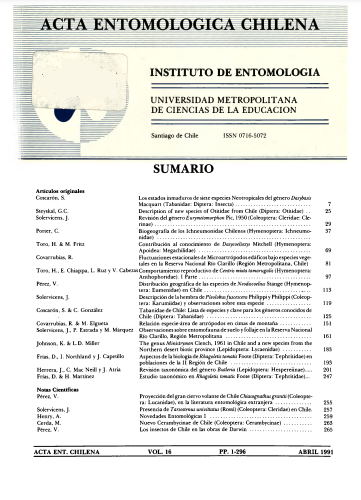Contenido principal del artículo
oct 26, 2022
Resumen
from the 24lh to the 18lh parallel (continuing northward almost to the equator as the Peruvian Coastal
Desert and Precordillera) and (2). The Neantartic Realm including all Chile south of the 25lh parallel as
well as a narrow strip of western Argentina south or the 38,h parallel.
Below 3000 m, the Northern Province is an almost absolute desert, where life is confined to river
valleys and oases. These lowland refugia are inhabited by a depaupérate biota with few endemic but
many Neotropic, Andino-Patagonian, and Cosmopolitan genera although with numerous endemic
species. Between 2000-3500 m most of the Neotropic genera disappear, but from 3000 m to the
showline annual precipitation increases and allows development of a diverse Andino-Patagonian flora
and fauna similar to that of the central Andes in Perú and Bolivia but with a large component of
endemic species and subspecies.
The Neantarctic Realm embraces habitats from semidesert in the north through sclerophyll
woodland at intermediate latitudes to humid Nothofagus Forest below the 38lh parallel. The
Neantarctic biota differs strongly from that in the rest of South America and can not be included as a
subelement of the Neotropic. It has 121 ichneumonid genera of which 39 (32%) are endemic, 31 (26%)
Cosmopolitan, 20 (16.5%) Holarcticor Holarctic-Oriental, 17 (14%) Neotropic, 8 (6.6%) Andino-Patagonia
with frequent representation in the Coastal mountains of south Brasil, 4 (3,3%) transantarctic
with species in Neantartic Chile as well as in Australia and sometimes also New Zealand, and with 3
genera (2.4%) widely but disjunctly distributed in both the Northern and Southern Hemispheres.
Clearly, the outstanding anomalies of the Neantarctic ichneumonid fauna are its exceptionally high
number of endemic genera and its surprisingly few Neotropic genera for an area in geographic
proximity to the American Tropics.
It is hypothesized that the main lineages within the Ichneumonidae were already present in the
Cretaceous, at a time when the world’s continents were still united by land bridges and the global
climate was rather uniformly humid and much warmer than at present. A diverse biota evolved on
Antartica at this time and was extensively shared with Southern South America and Australia up to the
Eocene. The aberrant and endemic biota of Neantarctic South America probably represents survivors
which moved north from Antartica before that continent’s glaciation. By the middle Tertiary,
mountain building, desertification, and coid climatic pulses had isolated the Neantarctic Realm all
along its eastern and northern boundaries, so that its biota has evolved in isolation for perhaps the last
40 million years. Lack of biotic continuity between Neantarctic semideserts and the spatially adjacent
North Chilean and Peruvian Coastal Desert seems hard to explain. How Southern Antofagasta
Province between 24-24 degrees south is extremely dry and is occupied by several mountain chains
averaging 2-3000 m in altitude and extending almost to the coast. This is the only barrier of its kind
along Pacific South America between the equator and Tierra del Fuego. During later Tertiary and
Pleistocene coid periods, these mountains must have been glaciated, or both very coid and very dry, so
that the Neantarctic biota could retreat no farther north at times of clima-deterioration from other
South American lineages, locked by physical and climatic barriers into a narrow strip along the Pacific
Coast and west of the Andes between Tierra del Fuego and Antofagasta.


